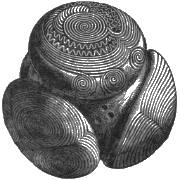Canmore Site 32289: LOCH OF KINNORDY - KIRRIEMUIR - LOGBOAT
Description
| Site Name | LOCH OF KINNORDY |
|---|---|
| Other Name(s) | LOCH KINNORDY |
| Site Number | NO35SE 12 |
| Broad Class | MARITIME CRAFT |
| Site Type(s) | LOGBOAT |
| NGR | NO 36 54 |
| NGR accuracy | NGR given to the nearest 1km |
| Local Authority | ANGUS |
| Parish | KIRRIEMUIR |
| Record created | 1988-02-29 |
| Last updated | 2000-04-12 |
Archaeology Notes
NO35SE 12 c. 36 54
See also NO35SE 7.
An oak, dug-out canoe, 15' by 3' found in 1820 in the peat of Loch Kinnordy, near the possible crannog (NO35SE 7), was preserved in Kinnordy House in 1884 but has been in Dundee Museum since 1966. (Acc. No. 1969-256). The prow is carved in the form of an animal's head.
C Lyell 1829; NSA 1845; A J Warden 1880-85; H Coutts 1971.
In 1820 a logboat was discovered during marl-digging in the partly-drained Loch of Kinnordy, which is situated in cultivated clayland at an altitude of about 140m OD. It was near the crannog that had been revealed during eighteenth-century drainage operations and has been identified with a mound at NO 3667 5441. The published section shows the boat to have lain horizontally in the upper layer of marl and immediately below the peat layer. Hutcheson adds that it was found at a depth of about 10' (3m) and that a 'thunderbolt axe' (probably a polished stone axe) was found in it but subsequently lost. Cervid bones were also found in the layer.
The boat was recorded by (Sir) Charles Lyell, the eminent geologist, and was found to be of 'oak' it measured 15' (4.6m) in length 'from bow to stern' and its 'width within' was 3' (0.9m). No evidence of propulsion was seen but within the stern there was a 'seat for the boatman' while the prow 'had evidently been carved into an ornamental shape, representing, apparently, the head of some animal'. The boat was analysed in its geological context and assumed to be of prehistoric date, as Lyell noted that 'it shows, that some part even of the peat, which overlies all the marl, is of a date anterior to the historical records of the county'. The boat has, however, since been radiocarbon-dated to 735 +/- 40 ad (Q-3142), which determination may be calibrated to about 791 or 801 cal AD.
The boat was kept for some years in Kinnordy House but is now in store at Dundee Museum and Art Gallery under accession number DMAG 69-256. The starboard side was difficult of access at the date of visit. It has suffered considerable splitting and gross deformation through warping so that the bow has been twisted through about 45? to port, causing a much-distorted plan view to be presented. The large gash in the forward section of the starboard side was possibly caused during recovery operations.
The workmanship displayed in the boat is of an unusually high order, there being little differentiation internally between the sides and the bottom, which only measure between 20mm and 40mm in thickness in spite of thickness-gauges not having been used. The timber is generally smooth and relatively free of knots, and there are slight traces of possible toolmarks internally amidships and near the stern. The exterior displays a slight chamfer in the lower part of the sides.
After shrinkage, the boat measures 4.32m in length over all and up to about 0.85m in beam. It has probably been parallel-sided on plan although the variation in the heights of the side presents a misleading impression in plan view. The sides themselves survive to a height of about 0.35 amidships but rise to about 0.65m at the pointed bow, where the possible animal head that Lyell noted is probably to be explained as fortuitous, although the hole may have served to retain a boat-rope. The stern is solid and square-cut internally but is externally sub-rectangular. The fitted seat has been lost and no support for it can now be distinguished.
Making allowance for distortion in shrinkage, the slenderness coefficient of this boat was 4.3, the beam/draught coefficient was 1.3 and the displacement under standard conditions was about 1.43 cubic metres, indicating that this was a small and general-purpose craft. The McGrail morphology code for this boat is 532:1x2:352 and the form is dissimilar-ended.
C Lyell 1829; A J Warden 1880-5; [Dundee] Evening Telegraph, 13 August 1895; [Dundee] Evening Telegraph, 19 August 1895; A Hutcheson 1897; H Coutts 1971; S McGrail 1978; S McGrail 1987; R J C Mowat 1996, visited August 1987; information from Miss C Lavell.
Identifiers and Links to Other Records
This record has no links! Would you like to help?
| Identifier / External Link | Linked Record | Status | Comment |
|---|---|---|---|
| Canmore Site Number (legacy): NO35SE 12 | No linked record |
This area is visible only to logged in users.
